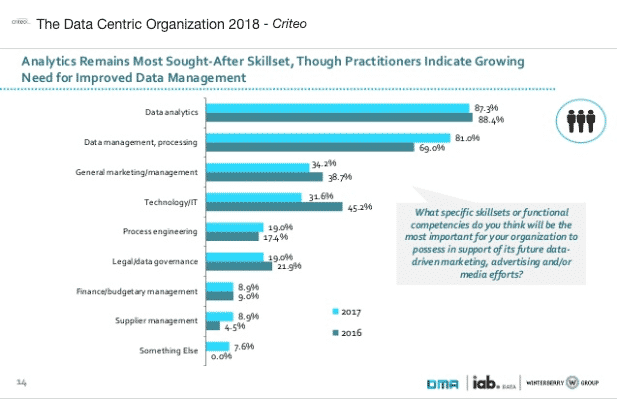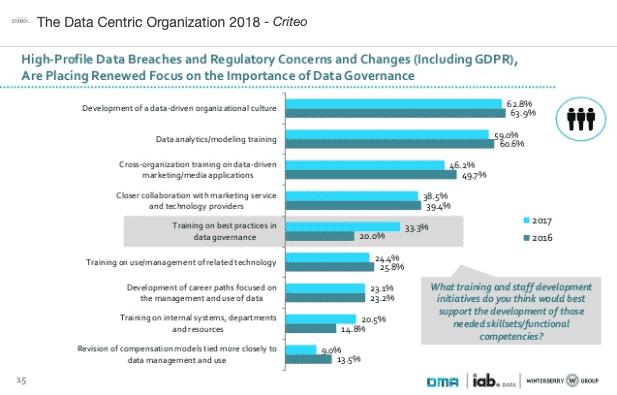In 2008, Nike, in a decision driven by their customer data, shifted its marketing strategy into one they call “category offense.” Rather than segment their audience by geography, they did so by the sports they played. The idea was that, regardless of the country they lived in, basketball players had more in common with other basketball players, and runners with other runners than they did with their non-athlete neighbors.
As a result of becoming a data centric business, sales rose more than 70%.
Almost ten years later, in keeping with what their data was telling them, Nike has launched a “Consumer Direct Offensive,” a demographic-based marketing strategy that focuses on serving their consumers personally, at scale. In a move to “create a local business on a global scale,” Nike aims to deeply serve consumers in twelve key cities across ten key countries.
The twelve key cities are expected to represent more than 80% of Nike’s projected growth through 2020. Less than six months later, the brand reported a revenue increase of 5%. Though the long-term results of Nike’s Consumer Direct Offensive remain to be seen, it’s clear that Nike’s plan is off to a strong start.
Clearly Nike knows how to leverage their data. And the company is proof that data efforts can pay off.
As a brand or retailer, you’re probably swimming in a sea of customer data, too. But are you a data-centric company, or are you actually just a company that happens to have a lot of data? While every marketer today knows that data is crucial to the business, very few have plans in place that make the most of it.
Only 1.3% of Marketers Feel “Extremely Confident” about Data
In a recent research report, “The Data-Centric Organization 2018,” the Winterberry Group, in partnership with the Data and Marketing Association (DMA) and the Interactive Advertising Bureau (IAB) surveyed over 110 marketers and publishers to find that 90.1% are “intensely focused on achieving ‘data-centricity’ across their organizations.”
Just 1.3% said they were “extremely confident” their organizations have the right expertise, experience, and skills to get the most value out of their data. More than 87% responded that of the skills most needed to maximize data usage, data analytics was at the top.

And achieving true data-centricity requires much more than just a team of data scientists. The report defines “data centricity” as “the extent to which an organization is culturally and operationally oriented to apply audience data as a source of actionable insight in support of advertising, marketing, audience engagement – and broader enterprise focuses.”
This means your organization needs to invest not just in data analytics, but across four operational pillars: People, platforms, partners, and processes.

It’s not unusual, when thinking about human resource gaps in data-centricity, to hone in on a lack of a strong data team. But becoming a truly data-centric organization goes beyond hiring a team of strong data analysts.
For Charlie Cole, the chief digital officer of Tumi, turning the luggage company into a premium began with data. And, more importantly, training every team – from the sales associates to the Creative Director – on how to fully grasp “the omnichannel effects of data.”
“Never forget that your data is there to support your product and your brand,” said Cole recently at AgilOne’s Customer Data Platform. “If you don’t educate people on [the effects of data], your organization will have huge blind spots.”
In practice, this means using data to inform the Creative Director of what product lines that are doing well – or not – and why. It also means using data to encourage store associates to allocate their time to omnichannel rather than just in-store activities.
Using data, Cole’s team reconfigured Tumi’s email segmentation, personalization, and customer targeting strategies. Tumi sent out 40 million fewer emails in 2016 than the previous year, contributing to a 28.5% increase in revenue. Tumi also revamped store marketing so that store associates spent more time making personalized phone calls to likely prospects rather than just focusing on in-store sales.
(Learn more: Clean Your Data, Trust the Machine: 6 Key Takeaways from AgilOne’s Customer Data Platform Summit 2018)

Let’s say by now, you know what you have to do when it comes to people. The next step is twofold: making sure your people have access to the right tools, and then ensuring those tools are integrated with your existing systems.
If you think of all the streams of data your organization needs to crunch on a daily basis to understand your customers and their activities, it can get overwhelming. Here’s a short and by no means comprehensive list of where your data is coming from:
- Web analytics
- Cloud POS customer data
- Cloud POS product data
- SKU data
- Social media
- Email marketing
- Mobile
- App
- CRM
- Third-parties
That’s a lot of data. How can you be sure you’re getting as much as you can not only out of each stream, but out of all the streams together? By using the right tools to support audience building, insight development, analytics, and measurement, you’ll benefit from built-in functions rather than having to create them yourself.
Below are some common data analytics tools, divided into three key stages of the data analytics journey.
1. For Data Integration and Management
This is the first, foundational step of data analytics, also known as the ETL stage, for Extraction, Transformation, and Loading. Data is pulled from disparate sources, cleansed (deduped, sorted, and validated to meet your business requirements), and delivered to the database or warehouse where you’ll carry out your data-driven business initiatives.
If this stage isn’t done right, then the analytics or visualization stages that follow won’t be as effective nor accurate as they could be.
Common platforms for the ETL stage include:
- SAS Data Management
- IBM InfoSphere Information Server Enterprise Edition
- Powercenter Informatica
2. For Data Analysis
This stage is where things get fun, and oftentimes, where machine learning comes into play. For data to transform your customers’ experiences and business models, you must learn to understand and use your data in the most strategic and predictive ways possible. You can’t just react to the data, you have to learn from it and you’re your business and marketing strategies accordingly.
This is where data analytics becomes crucial. To return to the aforementioned Nike example, the brand, in launching their “Category Offense,” found that it wasn’t geography that was pulling their top spenders together but the shared love for a sport.
Here are some popular data analytics tools you can use to take your insights to the next level:
- Targit
- Domo
- Google Analytics
- Adobe Predictive Analytics
3. For Data Visualization
There’s a good amount of overlap between tools for data visualization and the data analysis tools above, but different businesses benefit from different ways of displaying data for better comprehension. For instance, Tableau helps businesses quickly comprehend data in a graphical formats while Highcharts supports various types of charts from splines and area-splines to columns and scatter charts.
Some popular tools for data visualization are:
- Qlik
- Tableau
- Highcharts
- Microsoft Power BI
For many companies however, a shortcut to data-centricity can be found under the third pillar: Partners.

Overall, the Winterberry report finds, marketers are only moderately confident in their existing marketing technologies and the level to which those technologies can support the best use of audience data. And among the top five choices of what marketers think would best support data-driven marketing is “Closer collaboration with marketing service and technology providers.”

The same can be said of the companies who partner with Criteo. Criteo’s clients rely on the Criteo Engine and Criteo Shopper Graph. The Criteo Engine organizes and analyzes insights on over 1.9 billion monthly active shoppers and over $800B worth of ecommerce transactions every year, while the Shopper Graph takes three types of granular data: identity, interest, and measurement, to inform Criteo solutions to acquire, convert, and re-engage shoppers across our ecosystem.
By partnering with Criteo, New Look, a leading UK global fashion retailer, engaged with a wider audience and generated more revenue. Criteo applied machine learning and personalized product recommendation technology to help New Look increase their new customer rate by 62%.
And for some companies, working with a seasoned technology partner can help them stay on the right side of the law. With the enforcement of the General Data Protection Regulation (GDPR) for instance, companies that don’t have the right processes and governances in place to manage their data might face massive fines and, perhaps, long term damage to their business.
GDPR compliance can be time-consuming and expensive so a possible solution, as a recent TBR report suggests, is for companies to partner with solutions providers who “understand regional nuances and can demonstrate the capability to address regulatory concerns.”
Increasingly, companies are looking to leverage support from third parties to optimize their data usage across platforms and channels. Competition is fierce, and the companies with not only the most data but also the tools and skills to deploy it will take the lions’ share of profits.
(Learn more: GDPR: What You Need to Know)

Is your company’s overarching organizational structure designed to support effective data collection, management, and sharing? Do you have good governance policies in place?
A common misconception is equating data management to data governance. At its core, governance is what data means to a company: where it’s used, what rules it needs to follow, and most importantly, how accurate it is.
The structure can be different across different organizations, but there are three key steps every organization can take to implement data governance:
1. Take stock
The first and crucial step of successful data governance is to understand the data: both its type and quality, and to make sure its definitions are agreed upon and understood by each applicable person in the organization. Also, how sensitive is the data and what is “clean” data as defined by your company? It sounds simple, but it’s common to find people working side by side, trying to solve the same problems and yet have different definitions for common business terms.
Once these things are established, it’s then about having everyone in the organization understand and know where and how to access the data.
2. Transparency, Training, and Tracking
Transparency, training, and tracking go hand-in-hand.
For Tumi, having employees across the company see and understand what results the data was driving was imperative to Tumi’s success. Training means that those who have access to the data know how to use and analyze it.
Tracking is especially important in an age where data leaks can mean a company’s demise. Knowing exactly who has access to the data – and why – is critical in ensuring your data is neither misused nor misinterpreted.
To know that all three of these are being carried out with the company’s goals and best interests in mind often fall to the people who understand the data best, and can lead the organization through data governance programs and action lists.
3. Roles & Responsibilities
Even with the best talent, platforms, and partners, not having the right processes in place to secure and ensure the longevity of those pillars won’t do your organization much good.
And sometimes it’s the law. With the imminent enforcement of the General Data Protection Regulation for instance, companies that don’t have the right processes and governances in place to manage their data might face massive fines and, perhaps, long term damage to their business. And many companies aren’t yet prepared for GDPR.
Sometimes, as is the case with the GDPR, appointing a Chief Data Protection (CDP) officer is required by law to ensure good data governance and privacy. (Most) other times, depending on the size and nature of your company, it’s just a good idea.
By establishing clear roles and responsibilities from the strategic down to the operational levels, you eliminate confusion about who owns what when it comes to your company’s data and its processes.
(Learn more: GDPR: What You Need to Know)
Data-Centric = Customer-Centric
Companies that invest in data-centricity can drive messaging, efficiency, and superior customer experiences across all functions, not just in marketing.
For Nike’s Consumer Direct Offensive initiative, data-centricity is not just to “move with the consumer,” but to “move ahead of the consumer.” Likewise for Tumi, a company that organized data to become predictive rather than reactive. In the end, putting your data at the center of your business is equivalent to putting your customer at the center of your business.
Read the report below, and check out our data hub!
https://www.slideshare.net/CriteoReports/dma-iab-winterberry-group-the-data-centric-organization-february-2018





















